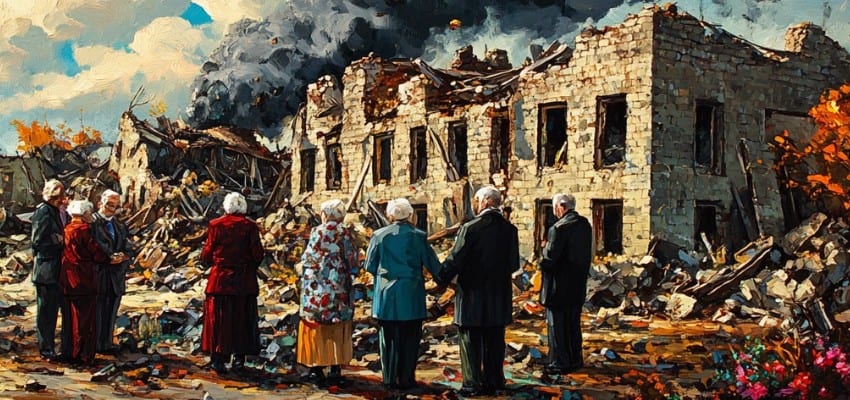Editor’s Note: This analysis provides a comprehensive breakdown of the most recent developments in Ukraine’s ongoing defense against Russian aggression, as reported by the Institute for the Study of War (ISW) on September 20, 2024. Highlighting Ukraine’s strategic military successes, particularly in Kursk Oblast, and the increased financial backing from European partners, the report underscores both operational and political dimensions of the conflict. This article aims to present an informed, fact-based overview of the current state of military operations, international support for Ukraine, and the broader implications for regional stability.
For those seeking to grasp the full scope of this evolving landscape, the complete updates from the Institute for the Study of War serve as an invaluable resource.
Content Assessment: Ukraine Secures Gains in Kursk as EU Pledges Billions for Defense and Infrastructure
Information - 93%
Insight - 92%
Relevance - 91%
Objectivity - 94%
Authority - 95%
93%
Excellent
A short percentage-based assessment of the qualitative benefit expressed as a percentage of positive reception of the recent article from ComplexDiscovery OÜ titled, "Ukraine Secures Gains in Kursk as EU Pledges Billions for Defense and Infrastructure."
Background Note: ComplexDiscovery’s staff offers distinctive perspectives on the Russo-Ukrainian war and Iran-Israel conflict, informed by military experience on the West German, East German, and Czechoslovakian border during the Cold War and in Sinai as part of Camp David Accord compliance activities. This firsthand regional knowledge has been further enhanced by recent staff travels to Eastern European countries, including Estonia, Latvia, Lithuania, and Poland. These visits have provided up-to-date, on-the-ground insights into the current geopolitical climate in regions directly impacted by the ongoing conflict.
Combined with cybersecurity, information governance, and eDiscovery proficiency, this multifaceted experience enables comprehensive analysis of these conflicts, including the critical impact of cyber warfare, disinformation, and digital forensics on modern military engagements. This unique background positions ComplexDiscovery to provide valuable insights for conflict-related investigations and litigation, where understanding the interplay of technology, data, and geopolitical factors is crucial.
Russo-Ukrainian Conflict Update*
Ukraine Secures Gains in Kursk as EU Pledges Billions for Defense and Infrastructure
ComplexDiscovery Staff
On September 20, 2024, Ukrainian forces continued to capitalize on their surprise incursion into Kursk Oblast, demonstrating a significant operational advantage over Russian defenses. Despite Russian authorities being forewarned of potential Ukrainian movements into the region as early as late 2023, they failed to adequately prepare their forces. The resulting Ukrainian incursion, which has gained operational momentum, exemplifies the strategic surprise that remains possible in modern warfare, despite Ukraine’s partially transparent battlefield. Meanwhile, European Commission President Ursula von der Leyen’s announcement of new financial mechanisms indicates robust continued support for Ukraine, further bolstering its defense industrial capacity and energy infrastructure needs.
Ukrainian Success in Kursk Oblast
Documents obtained by Ukrainian forces in Kursk Oblast reveal that Russian commanders had been aware of a potential incursion for months. However, Russian military units stationed in the area remained inadequately staffed and poorly trained, leading to significant vulnerabilities. Reports indicate that Russian military personnel in Kursk Oblast were operating at 60-70% of their intended strength, with reservists making up a large portion of their ranks. Despite calls for additional training, fortifications, and decoy positions, the Russian military command did not act on these warnings.
This failure led to Ukrainian forces achieving operational surprise. By obscuring their true intent and capabilities, Ukraine managed to mask the specific location and timing of their incursion. Reports suggest that Ukrainian forces integrated innovative techniques involving ground activity and unmanned systems, further complicating Russian defenses. ISW notes that this is a clear example of how even in a modern conflict, operational surprise can be achieved, given sufficient ambiguity around intent and readiness.
European Support for Ukrainian Defense
On the same day, European Commission President Ursula von der Leyen announced two significant financial loan mechanisms aimed at further supporting Ukraine’s defense and reconstruction efforts. The first loan, valued at €45 billion (approximately $50 billion), and a second loan of €35 billion (about $39 billion), will provide Ukraine with critical financial resources. Ukrainian President Volodymyr Zelensky confirmed that part of the €35 billion loan will be directed toward the purchase of long-range missiles, drones, and energy infrastructure, including the construction of bomb shelters.
Ukrainian Defense Minister Rustem Umerov stated that with the support of these funds, Ukraine could potentially produce up to $20 billion worth of defense equipment by 2025. This signifies the increasing capability of Ukraine’s domestic defense industry to contribute to the ongoing conflict, contingent on continued international support.
Russian Forces Struggle in Key Areas
Russian forces face continued pressure across several fronts, with mixed success. Recent reports suggest that Russian units made marginal advances near Vovchansk, Kreminna, Toretsk, and Pokrovsk. However, Ukrainian forces have successfully regained lost positions in Vovchansk and Siversk, further challenging Russian operational progress.
In northern Kharkiv Oblast, both Ukrainian and Russian forces continue to vie for control of key positions. Russian sources claimed marginal gains near the Vovchansk Aggregate Plant and Tykhe, though ISW has not confirmed these advances. Further south, Russian forces continue to press forward in eastern Donetsk Oblast, making incremental progress in Toretsk and near Pokrovsk. However, the situation remains fluid, with frequent back-and-forth exchanges of territory.
Russian Information Warfare and Mobilization
Russia continues to rely on propaganda and information warfare to support its military actions in Ukraine and justify its occupation of Ukrainian territories. During a recent meeting between Russian officials and the International Committee of the Red Cross (ICRC), Russia promoted unfounded allegations of Ukrainian human rights violations. Russian authorities sought to legitimize their occupation by engaging with international bodies like the ICRC while diverting attention from their own documented war crimes and abuses against Ukrainian civilians and prisoners of war.
On the mobilization front, Russian state media has increasingly emphasized the participation of foreign nationals in the war effort, particularly in Kursk Oblast, to downplay the need for another large-scale mobilization of Russian troops. Reports indicate that Chinese and Sri Lankan volunteers have joined Russian forces, reflecting the Kremlin’s efforts to maintain sufficient manpower without further escalating domestic unrest.
Missile and Drone Strikes Intensify
Russian missile and drone strikes continued to target Ukraine’s civilian and military infrastructure on September 19-20. Ukrainian air defense successfully intercepted 61 out of 70 Shahed drones launched from Russian positions in Kursk Oblast and Krasnodar Krai. However, some strikes caused damage to civilian infrastructure, including a retirement home in Sumy City. Ukrainian President Zelensky reported that nearly 300 elderly individuals were in the building at the time of the attack, underscoring the continued toll of Russia’s air campaign on Ukrainian civilians.
Ukrainian military analysts estimate that Russia has increased the intensity of its missile strikes but is constrained by production limits. Despite damaging 40-50% of Ukraine’s energy infrastructure last winter, Russia is unlikely to achieve total destruction, owing to improved Ukrainian air defenses bolstered by Western support.
Strategic Advances and Sustained Support Shape Ukraine’s Defense Against Russia
Ukraine’s surprise operations in Kursk Oblast have demonstrated the continued viability of strategic innovation on the modern battlefield, even against a well-informed adversary. Meanwhile, European financial support remains a critical pillar for Ukraine’s ability to sustain its defense and recovery efforts, highlighting the international community’s commitment to Ukrainian sovereignty. As Russian forces attempt to consolidate gains and defend against Ukrainian counteroffensives, the conflict remains dynamic, with both sides experiencing territorial shifts and operational challenges.
News Sources
As a leading source for cybersecurity, information governance, and legal discovery insights, including international investigations and litigation, ComplexDiscovery OÜ recognizes the importance of awareness regarding alleged and documented criminal acts, particularly in the context of the Russia-Ukraine conflict. While we, following the lead of the Institute for the Study of War (ISW), do not provide detailed coverage of war crimes in our primary reports, we encourage professionals within the eDiscovery ecosystem to stay informed about these activities. This awareness is crucial for understanding potential future legal actions and responsibilities.
Detailed Reporting with Maps for September 20, 2024, from the ISW – Mouseover to Scroll
Ukraine Control of Terrain - September 20 2024Review the Detailed Reporting and Maps PDF
About the Institute for the Study of War Research Methodology
ISW’s research methodology relies on both primary and secondary sources, enabling researchers to develop a comprehensive understanding of the situation on the ground. In order to analyze military and political developments in any given area, ISW’s research analysts must wholly understand the systems of enemy and friendly forces. They must also understand the population demographics, physical terrain, politics, and history of that area. This lays the analytical foundation for understanding the reasons for particular developments and fulfilling their assigned research objectives. ISW analysts also spend time in places like Iraq, Afghanistan, and elsewhere in order to gain a better understanding of the security and political situation and to evaluate the implementation of current strategies and policies. Our researchers compile data and analyze trends, producing a granular analysis of developments in areas of research, producing an accurate, high-resolution, timely, and thorough picture of the situation. ISW’s research methodology guarantees its success and commitment to improving the nation’s ability to execute military operations, achieve strategic objectives, and respond to emerging problems that may require the use of American military power.
About the Institute for the Study of War
The Institute for the Study of War advances an informed understanding of military affairs through reliable research, trusted analysis, and innovative education. They are committed to improving the nation’s ability to execute military operations and respond to emerging threats in order to achieve U.S. strategic objectives. ISW is a non-partisan, non-profit, public policy research organization.
Learn more, get involved, and contribute today.
Additional Reading
- From Dissent to OSINT? Understanding, Influencing, and Protecting Roles, Reputation, and Revenue
- [Annual Update] International Cyber Law in Practice: Interactive Toolkit
- Data Embassies: Sovereignty, Security, and Continuity for Nation-States
Assisted by GAI and LLM Technologies
* Sourced and shared with direct express permission from the Institute for the Study of War (ISW).
Source: ComplexDiscovery OÜ


























